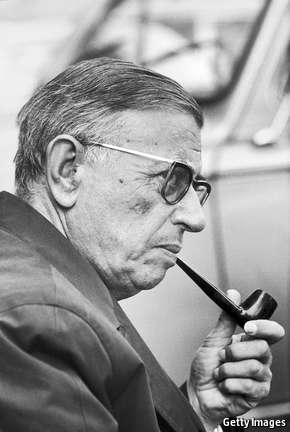Most technical philosophers tend to look at the
world as armchair scientists. They puzzle about time or knowledge, matter,
numbers and chance. They ask how such things really are. Sartre, who also wrote
bestselling fiction and plays, thought about the world as an off-duty novelist.
He asked what the world was like for people. They were not detached physicists
or passive observers. They lived, aided or obstructed by a material world, which
included their bodies. For good or ill, they were thrown into contact with
others. Sartre’s concern, in a phrase, was what it was like to be human. The
topic sounded unmanageable. But its core elements were familiar enough: the
mind, human values and human freedom. Sartre linked them together in big loose
equations.
The human mind was free, notably in its
imaginative capacity to entertain possibilities and think of the world as
different from how it was. People were free of religious or ethical authorities,
so obliged to find their own values. They were free finally to define themselves
or choose a form of life as they pleased, for there was no human nature—nothing
essential, that is—to being human. Those three freedoms added up to
“existentialism”, an otherwise obscure label by which Sartre’s thought became
known. How far it impresses you will depend on whether you prefer philosophy in
careful, dry bits or in bold flashes that briefly light up a
territory.
Sartre’s most famous philosophical treatise,
“Being and Nothingness” (1943), suffered from trying to embed pointed insights
into human thought and experience in a dense metaphysical theory that split not
just mind from world but the mind of any one person from everyone else’s. In
compensation, the book displayed Sartre’s rare psychological acuity and brought
out the pervasive role of the imagination.
Sartre stressed an ever-present emotional
element in human thinking that philosophers preoccupied with truth and validity
tended to overlook. He was fertile and original in putting previously neglected
mental phenomena such as shame, pride and fear at the centre of how to
understand self-awareness. To cultural and gender studies he bequeathed the
enticing idea that the judgmental look or predatory gaze of others shaped and
commonly distorted a person’s sense of who they were.
In a typical twist, Sartre added that people
were entirely free to reject the verdicts of others and their stereotyping. To
deny that freedom involved self-deception or bad faith. So, generally, did
blaming your situation on your past, your parents, the unconscious, social
pressures or human nature. Those were craven excuses. At any moment you could
avow or disavow your situation. Strictly, it was yours only once you claimed
ownership. Such freedom was daunting, Sartre recognised. In his brutal phrase,
everyone was “condemned” to be free.
In the philosopher’s superabundance of ideas,
imagination did most of the work. Neither passive nor whimsical, this power of
supposition underlay the simplest intentions and grandest plans. Its uses ran
from the banal and domestic to the heroic and political. As the power to suppose
that society might be different, imagination dominated Sartre’s radical
politics. on Paris walls in the student upheavals of May 1968 appeared the
Sartrean slogan, “Power to the imagination”.
Besides a weakness for overgeneralisation,
Sartre tended to over-empower the mind. At one extreme, he was never far from
gifting people with mysterious mental powers to shape events. His runaway prose
tended to blur the simple point that picturing a better society did not create a
better society. Imagination was needed for action but was never itself enough.
People still had to act.
At another extreme, Sartre risked lapsing into
stoical banalities. People had no protection, he admitted, against time, pain or
death. They were still free, the philosopher insisted, to say what those ills
meant to them. People were free to grant or deny value to life’s vicissitudes.
How far, though, did refusing “ownership” of pain remove pain?
Sartre’s published output is reckoned at 20
pages a day throughout his working life. No English-speaking philosopher has
read that vast corpus with greater industry than Mr Flynn. His new biography
scrutinises the works chronologically from start to finish. It includes Sartre’s
fiction and plays, as well as the political or critical essays. Mr Flynn has
done Sartrean initiates a large service, but this is not an
introduction.
Though he writes within Sartre’s thought, using
his vocabulary, Mr Flynn stresses unresolved puzzles. Technical philosophers can
sound as if they are trying to describe a world without humans, Sartre as if
describing human life without a world. Sartre saw the difficulty, but never
completed his later attempts to relocate the isolated mind of “Being and
Nothingness” in a social world of rights and duties. Nor did he let up on the
clash between limitless freedoms to change attitudes to a situation and their
apparent powerlessness to change the situation itself. A cheery, can-do sort
would say that life is not always so bleak. People are rarely or completely so
trapped. No, indeed. But sometimes they are, which is one reason why Sartre’s
work, though little read these days, remains interesting and even
topical.
